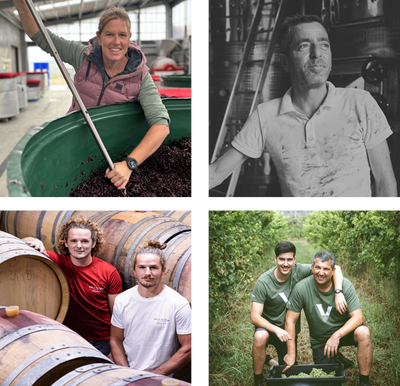1 - Natural
‘Natural wine’ is essentially a misnomer – after all, wine doesn’t occur spontaneously. It is made by humans. But even putting such pedantry to one side, strictly speaking ‘natural’ should only apply to wines that have been made with no interventions – wines which have been spontaneously fermented, that have not been fined or filtered, and to which no tannins, enzymes, vitamins, sugars, acids or – most importantly – sulphur dioxide (SO2) has been added. Only a vanishingly small percentage of wines are made this way. The truth is that SO2 is a very effective anti-oxidative and anti-bacterial agent. If used in moderation it can be a winemaker’s best friend. Conversely, if used too liberally, it can deaden a wine – sterilising it both literally and figuratively.
Ultimately as a broad umbrella term ‘natural wine’ can help to differentiate between industrially made and artisan wines, albeit with very blurred boundaries. But it’s when natural wine language takes an ideological turn that we get into a mess: raw, wild, pure, real, honest, conscious even - these are very virtue-signalling descriptions and ‘natural’ is of a piece with them. But it’s a bit presumptuous, isn’t it? There are plenty of wine producers out there who work carefully with minimal intervention who would feel a certain amount of justified indignation by being categorised as ‘unnatural, or impure, or dishonest’. Most quality-focused wine producers strive to make wine with as little interference as possible anyway and always have.

2 - Orange
No longer a sideshow, orange wines are de rigueur - although ‘skin contact’ would seem a more sensible umbrella term since some wines are several shades shy of orange. Orange wines are essentially white wines made like red wines – with skin maceration. Many of them are brilliant and add another element to the already lovely smorgasbord of wine styles; but just as has happened with Provence rosé, some cynical producers have sought to make orange wines almost entirely based on their hue rather than their taste... One other thing which has arisen from the fashion for orange wines is that they sometimes get conflated with ‘natural’ wines. It's useful to remember that while it’s true that most makes of orange wine tend to be those operating at the natural end of the spectrum, it is not always the case – and will increasingly not be the case as more commercial wineries jump on the orange bandwagon.

3 - Old vine
Ah the romance of the gnarly, 200-year-old, pre-phylloxera heritage vine, grinding out ambrosial little grape bunches like blood from a stone. It’s an oversimplification, sadly. Old vines are not enough on their own to make good wine. For some varieties – grenache, say - old vines are preferable; for others, roussanne for example, it makes no difference. Well-made wines from young vines can be superior to indifferently made wines from older vines too. Did you know that the Stag’s Leap wine which outperformed Bordeaux premier cru classé wines like Haut Brion in the famed Judgment of Paris tasting was made from vines that were a mere three years old? Often terms like vieille vigne and Alte Reben are pure marketing fluff. Far more important than having old vines is having good massal selection (planting from cuttings of a variety of the best-performing vines available) to ensure you have the diversity of fruit to make your wine interesting and complex.

4 – Wild-fermented
Anything ‘wild’ is just better isn’t it? Just as wild swimming is to be preferred to mere ‘swimming’, fermentation with ‘wild’ or ‘ambient’ yeasts has an irresistible esoteric allure to it. Or maybe not... It’s actually not as ‘out-there’ as you might think. Although industrial winemaking implies fermentation with ‘cultured’, off-the-shelf yeasts, it’s estimated that around 80% of winemaking is still done via spontaneous or ‘wild’ fermentation. According to Rhone winemaker Eric Texier it’s the most important element of vinification: it’s the natural microbial population that is present on healthy organic grapes, and in the micro-environment of a winery, that gives a spontaneously fermented wine its special and unique personality, he says.

5 - Vegan
When we're talking about whether a wine is vegan or not, we’re usually talking about the animal-based fining agents that can be used in the cellar. In the past, isinglass (collagen from fish bladders) was common; these days, gelatin, casein (milk protein) and albumen (egg whites) more so. What complicates the issue is that there is no obligation for winemakers to state on their labels whether they've used animal products. Labels like ‘unfined and unfiltered’ avoid doubt. Labels like ‘organic’ or ‘biodynamic certainly don’t. Even if a biodynamic producer avoids using animal proteins to fine their wine, what about the cow horn manure used to make Preparation BD500, or the crushed egg shells often used in soil treatments?

6- Minerality
Here's a term fraught with misunderstanding. It covers everything from acidity to terroir to reduction to something else, something beyond the fruit or fermented flavours of a wine, like sucking a stone. It’s usually seen as a good thing but it’s also a term that can explain away the dullness of a neutral wine. The thing about minerality which makes it different from other descriptors we have – pineapple, hay, old leather, whatever – is that it is usually taken literally. Be wary of that. Geological minerals - the ones contained in rocks - are not the same thing as the nutrient minerals that vines use to grow. Most nutrient minerals come from humus in the topsoil; the minerals in the vineyard bedrock are almost all insoluble. In other words, they aren’t available for the vine to take up. So whatever minerality is, it is not the literal taste of rocks.

7 - Amphorae
It’s the romance again, isn’t it? Amphorae, qvevris, tinajas - the perfume of history, the profundity of the very old. Though amphorae are very trendy, they have also encouraged winemakers to experiment away from steel and wood, and make stylistically original wines – they are porous like wood so have a comparable micro-oxygenating effect, but they impart no flavour (okay, maybe the ones lined with beeswax do a bit), meaning it’s the pure character of the fruit which defines the wine. This is great for those of us with oak fatigue, but we shouldn’t get carried away. Most winemakers will admit that they are just a piece of cellar equipment, like barriques, fiberglass, HDPE, stainless steel. They represent a technique, not a religion.


